MELeaf: A Newsletter From the Horticulture Program, July 14, 2021
In this issue:
European fire ant (Myrmica rubra) is a small stinging ant that has been established in parts of Maine for quite some time. These ants are not plant pests and the Horticulture Program does not inspect for or regulate them. However, we do know that European fire ants can move to new locations in plant pots and in soil or mulch. The potential of European fire ant to move with nursery plants and the health threat posed by its aggressive stinging behavior combined with recent inquiries from nurseries and other states has identified a need for the Horticulture Program to collect more information from plant sellers on their experiences with European fire ant. Please fill out this brief survey to help us determine if nurseries in Maine are experiencing impacts from European fire ant infestations and learn about steps nurseries may currently be implementing to prevent or control European fire ant.
Answers to the survey are anonymous. We do ask for an email address, but providing one is not required.
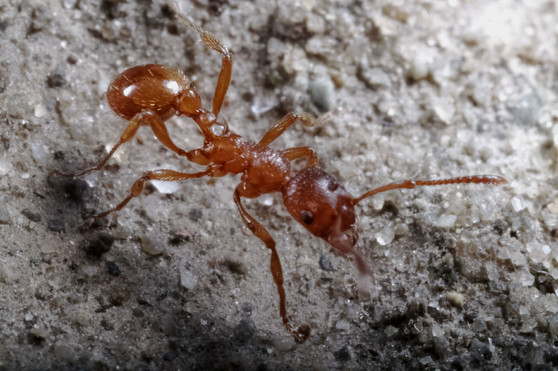 A European fire ant. (Gary D Alpert, www.antwiki.org)
Parts of Maine have experienced high populations of browntail moth this year, and empty allergy and itch cream shelves at pharmacies can attest to that. Since the beginning of July, Horticulture Program staff have been receiving reports of adult browntail moths being attracted to outdoor lights at some nurseries and garden centers. While it is generally the males that are attracted to lights, females tend to land on plant material in the surrounding areas and lay eggs. If eggs masses are laid on nursery stock that is then sold, infestations of browntail moth could move to new locations or become a problem for customers.
Browntail Moth Management Strategies for Nurseries in July and August (Adult Flight Season)
-
Train staff to recognize all life stages of browntail moth.
-
Reduce outdoor lighting to avoid attracting additional browntail moths to your business, consider converting to motion sensitive security lighting options.
- Do not store plants under lights.
-
Wash large infestations of moths off plants and buildings with a hose, then vacuum them up with a wet/dry shop vac with a HEPA filter following manufacturer instructions.
- Inspect plant material daily and remove any browntail moth adults and egg masses. Drop moths and egg masses into a container with 2-3” of soapy water will help reduce hairs being distributed and drown adults.
-
Remove all life stages of browntail moth before plants leave the nursery. This will prevent infestations from moving to your customers homes. Inspect plant material when being sold, especially deciduous trees, roses and plants that were stored near outdoor lights. Remove any adults or egg masses. Egg masses are usually laid on the underside of leaves and are fuzzy and brown.
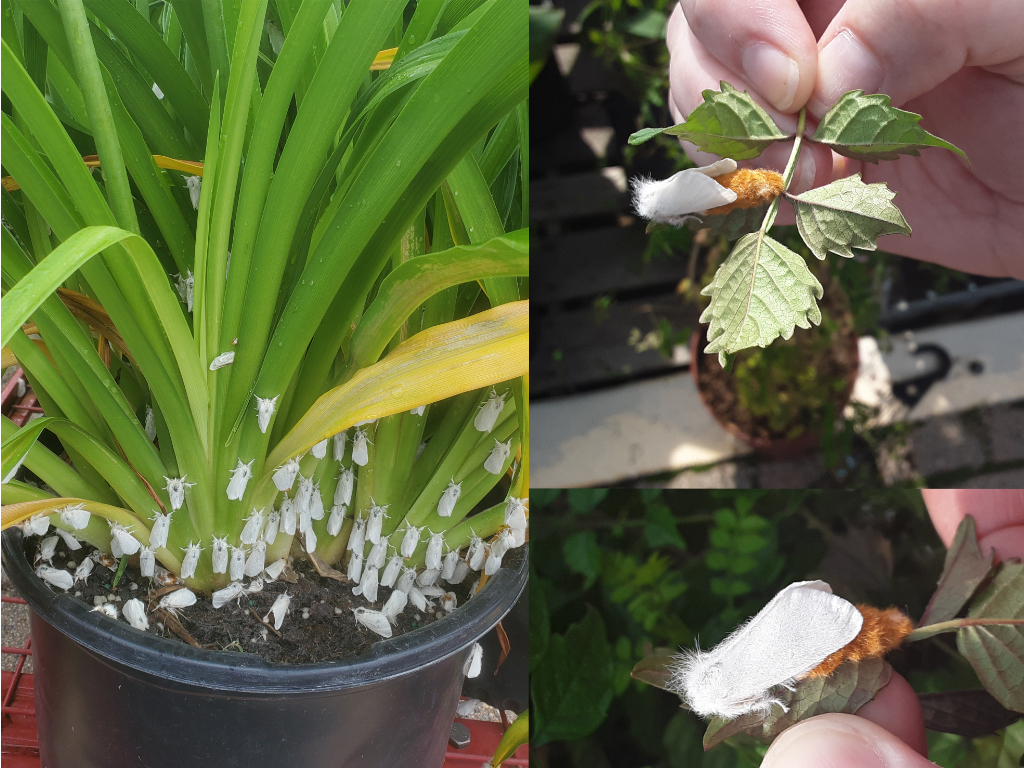 Left: Browntail moth adults clustered on a potted daylily (Auburn Conservation Commission). Browntail moth does not feed on daylilys, but the moths were likely attracted to the area by outdoor lighting. Right: Female browntail moths laying eggs.
We probably could have named this entire issue of the MELeaf "Pests to Watch." Here are three more new pests that the Horticulture Program is paying attention to. Two of the pests (box tree moth and elm zig zag sawfly) are new to the US, but have not been found in Maine yet. The third pest (beech leaf disease) was recently identified in Maine.
Beech Leaf Disease
The Maine Forest Service (MFS) shared the news last month that beech leaf disease (BLD), a disease that has caused beech mortality from Ohio to Southern New England, has been identified in Maine. BLD was confirmed in leaf samples from Lincolnville and since then symptoms have been observed in Waldo and Knox Counties from Belfast to Rockport and inland to Searsmont and Hope. MFS and the Horticulture Program believe that BLD is likely found elsewhere in Maine and encourage anyone that observes symptoms on planted beech trees in the landscape or forest, outside of the known infested area to submit photos using the MFS online reporting form. Try to include photos of the underside of the leaves.
Symptoms of beech leaf disease include:
-
Dark bands between the veins of leaves
-
Curled, deformed and shriveled leaves
-
Trees with a thin canopy
Recently, the Horticulture Program received information from our colleagues in Connecticut that they had identified BLD in nursery stock. The plants originated in Ohio and based on the shipment timing it is likely that the plants were infested prior to arrival in Connecticut. We encourage all nursery and garden centers that have beech in their inventory to carefully inspect plants for symptoms and report any suspicious plants by emailing pictures to horticulture@maine.gov. BLD can occur on both American and European beech.
More Information from MFS
More Information from NY State Including Look-a-likes
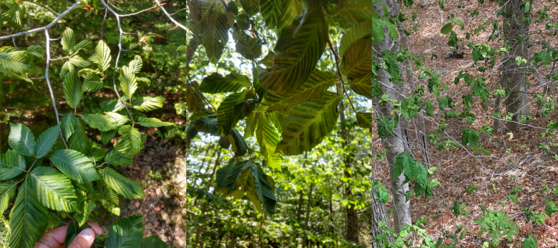 Beech leaf disease symptoms
Box Tree Moth
Box tree moth (Cydalima perspectalis) was found for the first time in the US this spring at several nurseries that received infected boxwood plants from a supplier in Ontario, Canada. This pest is native to Asia, but is also found in Europe where it spread rapidly after its introduction in 2007. Box tree moth was first documented in Canada in 2018. One potentially infested shipment was traced to Maine. This order, containing three 8” boxwood plants, was sent directly to a homeowner in Windham. The plants and property were carefully inspected, and while no signs of box tree moth were found, the plants were double bagged and destroyed as required by USDA.
Box tree moth caterpillars feed mostly on boxwood leaves and bark, which can defoliate, girdle and potentially kill the plants if left unchecked. Other potential hosts include burning bush and other Euonymus species and some holly species (Ilex spp.). Adult moths are good fliers and have naturally spread 3 to 6 miles per year in Europe, although long-distance movement occurs primarily through transport of infested plants. Signs of box tree moth include skeletonized leaves and insect frass, along with webbing which can sometimes be extensive throughout the plant. If you see signs of box tree moth on boxwood, please take a picture and report it to horticulture@maine.gov.
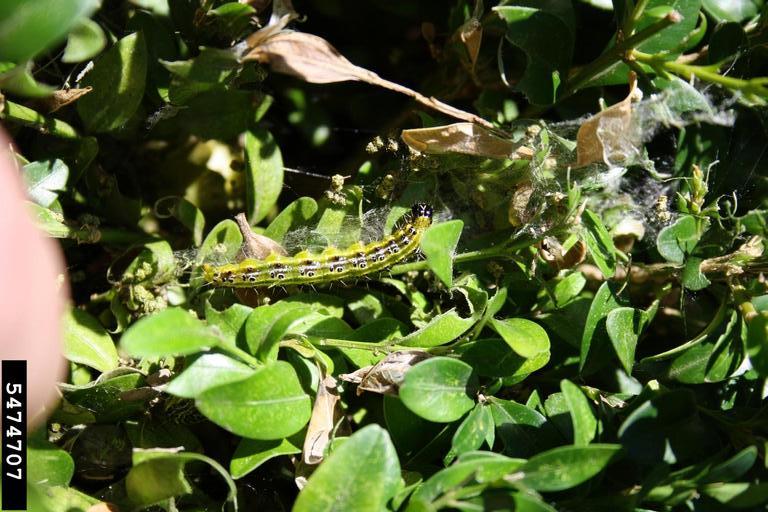 A box tree moth caterpillar. (Ferenc Lakatos, University of Sopron, Bugwood.org)
Elm Zig Zag Sawfly
Elm zig zag sawfly is a defoliator of elm trees that was first found in Quebec in July 2020 and was identified in Virginia earlier this year. The pathway for this pest’s arrival in North America remains unclear. As its name implies, elm zig zag sawfly feeds on various species of elm trees and the larvae feed in a characteristic zig zag pattern. The pest is expected to have up to 4 generations per year and larvae are likely to be found throughout the growing season. If you suspect you’ve seen elm zig zag sawfly in Maine, take a picture and send it to horticulture@maine.gov.
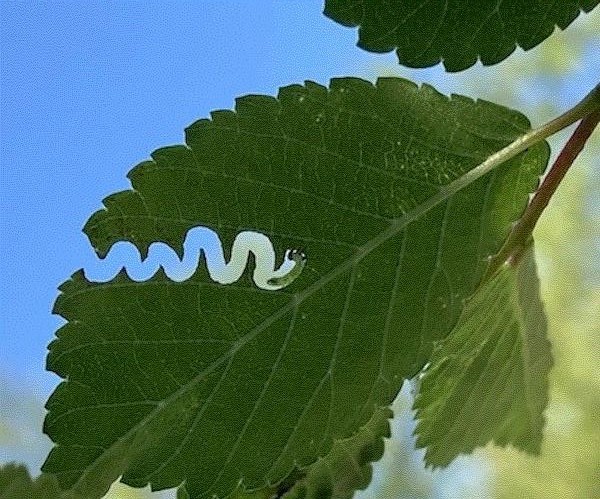 Elm zig zag sawfly larva and damage (Heather Huntington, Virginia Department of Agriculture and Consumer Services)
|